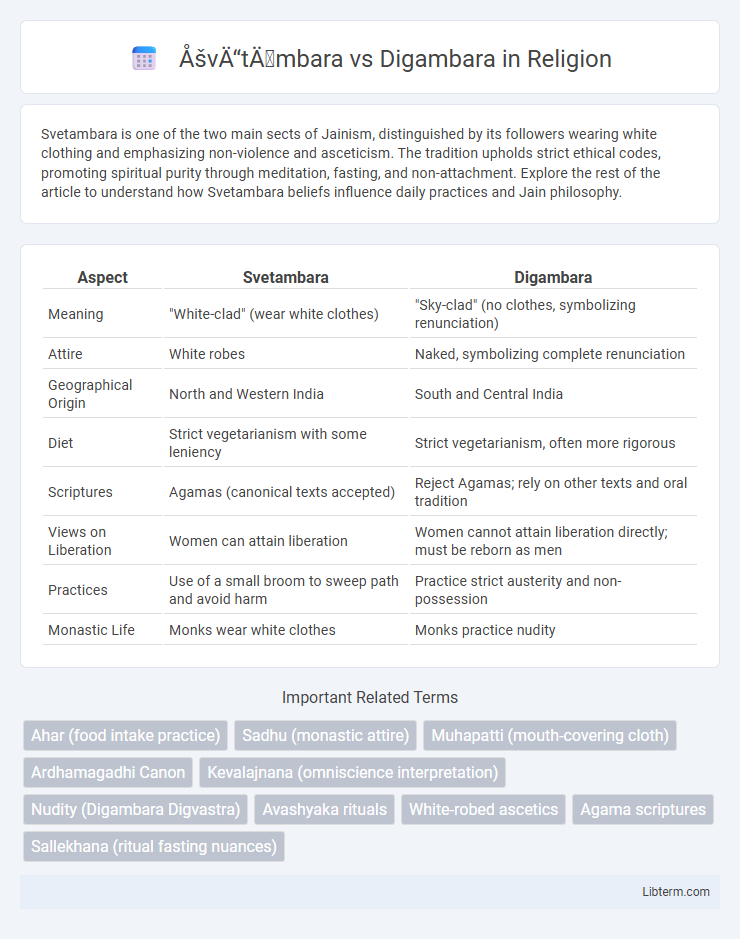Svetambara is one of the two main sects of Jainism, distinguished by its followers wearing white clothing and emphasizing non-violence and asceticism. The tradition upholds strict ethical codes, promoting spiritual purity through meditation, fasting, and non-attachment. Explore the rest of the article to understand how Svetambara beliefs influence daily practices and Jain philosophy.
Table of Comparison
| Aspect | Svetambara | Digambara |
|---|---|---|
| Meaning | "White-clad" (wear white clothes) | "Sky-clad" (no clothes, symbolizing renunciation) |
| Attire | White robes | Naked, symbolizing complete renunciation |
| Geographical Origin | North and Western India | South and Central India |
| Diet | Strict vegetarianism with some leniency | Strict vegetarianism, often more rigorous |
| Scriptures | Agamas (canonical texts accepted) | Reject Agamas; rely on other texts and oral tradition |
| Views on Liberation | Women can attain liberation | Women cannot attain liberation directly; must be reborn as men |
| Practices | Use of a small broom to sweep path and avoid harm | Practice strict austerity and non-possession |
| Monastic Life | Monks wear white clothes | Monks practice nudity |
Introduction to Śvētāmbara and Digambara Sects
Svetambara and Digambara are the two main sects of Jainism distinguished by their distinct religious practices and interpretations of canon. Svetambara monks wear white robes and emphasize accessibility in rituals and scriptures, while Digambara monks practice strict asceticism by renouncing all possessions, including clothing. These differences reflect broader theological contrasts, such as the depiction of liberated souls and gender roles in spiritual progression within Jain philosophy.
Historical Origins and Development
Svetambara and Digambara sects of Jainism originated around the 3rd century BCE, diverging primarily over interpretations of ascetic practices and monastic discipline. Svetambaras, meaning "white-clad," historically emphasized wearing simple white garments, while Digambaras, meaning "sky-clad," adopted nudity as a symbol of renunciation, reflecting distinct doctrinal stances on material possession and spiritual purity. Archaeological findings and ancient scriptures like the Kalpasutra and Mulachara highlight their separate development paths, shaping differing rituals and philosophical doctrines within Jain tradition.
Core Philosophical Differences
Svetambara and Digambara sects of Jainism differ fundamentally in their interpretations of ascetic practices and spiritual liberation; Svetambara monks wear white clothing symbolizing purity, whereas Digambara monks practice nudity, emphasizing complete renunciation. The sects diverge on the nature of the soul's liberation, with Svetambaras believing that liberated souls can have form and bodily existence, while Digambaras assert that liberation entails formlessness and total invisibility. Textual authenticity is also a point of contention, as Svetambara accepts the Agamas as canonical scriptures, whereas Digambara rejects them, relying instead on other ancient writings to guide their doctrines.
Distinctive Religious Attire and Practices
Svetambara monks wear simple white robes symbolizing purity, while Digambara monks practice strict nudity representing renunciation of material possessions. Svetambara nuns also wear white attire, contrasting Digambara nuns who traditionally don't exist due to the vow of nudity being exclusive to men. Both sects follow differing rituals related to asceticism, with Digambaras emphasizing severe austerities and Svetambaras adopting a more moderate approach.
Doctrinal Beliefs on Liberation and Spirituality
Svetambara and Digambara sects differ significantly in their doctrinal beliefs on liberation and spirituality. Svetambara adherents believe that liberation (moksha) can be achieved by following strict ethical conduct, acquiring right knowledge, and practicing non-attachment while wearing white garments symbolizing purity. Digambara monks practice nudity to symbolize complete renunciation and hold that true liberation requires abandoning all possessions, with women perceived as needing rebirth as men to attain moksha.
Views on Women and Asceticism
Svetambara sect permits women to become ascetics and attain liberation, viewing them as capable of spiritual progress through monastic discipline. Digambara sect holds that women cannot achieve liberation without first being reborn as men, emphasizing strict ascetic practices, including complete nudity, which women cannot observe. This fundamental difference shapes their respective monastic codes and interpretations of spiritual purity and liberation.
Sacred Texts and Scriptural Acceptance
Svetambara Jainism accepts a broader canon of texts, including the Agamas, believed to be the direct teachings of Lord Mahavira, preserved in written form and studied extensively in their communities. Digambara tradition, however, rejects the existing Agamas, asserting they were lost over time and relies heavily on commentaries and later scriptures such as the Satkhandagama and Kasayapahuda composed by Acharyas in the early centuries CE. This divergence in scriptural acceptance shapes the doctrinal interpretations and ritual practices distinctive to each sect, reflecting differences in textual authority and historical transmission.
Temple Architecture and Iconography
Svetambara temple architecture features elaborately decorated facades with intricately carved marble and ornate domes, emphasizing open and airy mandapas for congregational worship. Digambara temples typically showcase simpler, more austere designs with plain stone structures and towering spires that symbolize ascetic ideals. Iconographically, Svetambara idols are adorned with white robes and often depict Tirthankaras with a subtle smile and eyes partly open, while Digambara images are nude and portray Tirthankaras in strict meditation with closed eyes, reflecting their doctrinal emphasis on renunciation.
Major Festivals and Rituals
Svetambara followers observe Paryushana and Das Lakshana as major festivals emphasizing forgiveness and self-discipline, while Digambara celebrate Paryushana with a focus on austerity and penance. Both sects perform rituals such as Pratikraman, but Svetambara rituals often include elaborate temple worship and fasting practices, whereas Digambara rituals emphasize asceticism and meditation. The festivals highlight core Jain values like non-violence, truth, and spiritual purification, each adapted to sect-specific doctrinal interpretations.
Contemporary Influence and Global Presence
Svetambara Jainism, characterized by its white-clad monks and greater emphasis on scripture, has a substantial contemporary global presence with active communities in India, North America, and East Africa, fostering international dialogue and cultural exchange. Digambara Jainism, distinguished by its ascetic nudity and rigorous monastic practices, maintains a strong influence primarily in India, with growing scholarly interest worldwide due to its unique philosophical contributions and preservation of traditional rituals. Both sects contribute significantly to global Jain identity through international conferences, digital platforms, and interfaith engagements, promoting the religion's core values of nonviolence and spiritual liberation.
Śvētāmbara Infographic

 libterm.com
libterm.com